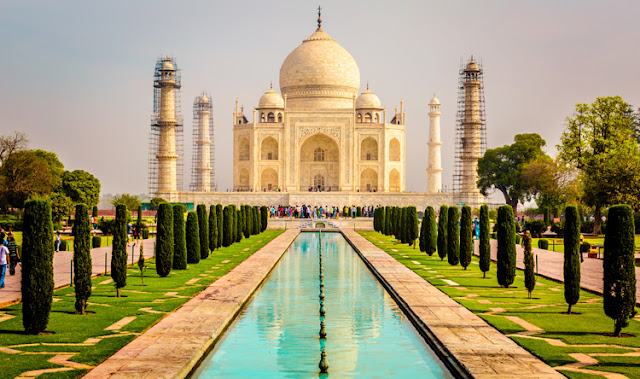As soon as the fifth Mughal emperor Shah Jahan fell ill in September, 1657, it sparked a deadly war of succession among his four sons – Dara Shikoh, Shuja, Aurangzeb and Murad. In this fratricidal war of succession, his two daughters Jahanara and Raushanara sided with Dara Shikoh and Aurangzeb respectively.
This blog is a comprehensive and in-depth guide to the events, people and places throughout the history of India
Saturday, February 23, 2013
Aurangzeb and Mughal War of Succession
As soon as the fifth Mughal emperor Shah Jahan fell ill in September, 1657, it sparked a deadly war of succession among his four sons – Dara Shikoh, Shuja, Aurangzeb and Murad. In this fratricidal war of succession, his two daughters Jahanara and Raushanara sided with Dara Shikoh and Aurangzeb respectively.
Wednesday, February 20, 2013
Mumtaz Mahal (1593- 1631)
Mumtaz Mahal ("Jewel of the Palace") is the woman whose mausoleum is popularly known as Taj Mahal, arguably the most famous symbol to royal love in the world. Located in Agra in the Indian state of Uttar Pradesh, Taj Mahal was built by her husband Shah Jahan, the fifth Mughal Emperor.
Tuesday, February 19, 2013
Khusrav Khan donning the role of Malik Kafur
In April 1320, Mubarak Shah was murdered by Khusrav Khan bringing the Khilji dynasty to an end. Khusrav Khan ascended the throne of Delhi under the title of Nasir-ud-din Khusrav Shah and tried to strike a veritable reign of terror by murdering the relatives, friends and those loyal to the Khilji Sultan.
If historians like Barni, Yahiya Bin Ahmand Sirhindi, and Ibn Batutah are to be believed, Khusrav gave preferential treatment to the Hindus. This was resented by the Muslim nobles specially the Alali Nobles who invited Gazi Malik, the noble of Dipalpur, to put an end to the reign of Khusrav Khan. Gazi Malik defeated Khusrav at Delhi on the 5th September, 1320 and beheaded Khusrav. Gazi Malik became the Sultan of Delhi Sultanate under the title of Ghiyas-ud-din Tughluq and the dynasty, he founded, is known as Tughluq dynasty.
Thursday, February 14, 2013
Akbar and His Concubines
Monday, February 11, 2013
Black Hole Incident of Calcutta
Thursday, February 7, 2013
The First Anglo-Afghan War: A Disaster for Britain
 William Brydon riding into Jalalabad/Wikipedia Commons
William Brydon riding into Jalalabad/Wikipedia CommonsThe First Anglo-Afghan War (1839-1842) caused the greatest misfortune that ever befell the British army and dealt a severe blow to their prestige in India.
With the fall of Napoleonic France in 1814, Russia had emerged as Britain’s potential rival by 1830s. India was the prized possession of the British Empire at that time. Russia has made its Asiatic ambitions clear. But to realize its ambition it would have to gain a diplomatic and military foothold in Afghanistan, an insignificant and impoverished tribal society in the early 19th century.
Instead of entering into an alliance with Afghanistan’s ruler, Dost Mohammad, Britain chose to back Shah Shuja, the deposed ruler of Afghanistan, who had been living in exile in India for three decades.
In 1837, Alexander Burnes, an envoy sent by George Eden (Lord Auckland), the then Governor-General of India, reached Afghanistan. The Afghanistan’s ruler Dost Mohammad was willing to have the British as his ally but he sought British help in restoring the lost province of Peshawar to him from the Sikh leader Ranjit Singh. Lord Auckland cited the doctrine of non-intervention in the affairs of the States for his inability to help Dost Muhammad. Consequently the negotiation, which was not conducted in right earnest, failed. Auckland was adamant on deposing Dost Mohammad who was a capable ruler. He chose to back Shah Shuja. Unable to secure British friendship, Dost Muhammad sought Russian help. Until treated insignificantly, Russian envoy Viktevitch was now received by him with favour.
Now the stage was set for the inevitable war of the English with Afghanistan. Britain initially gained success. Under the supreme command of Sir John Keane, the British army occupied Qandahar in April 1839, stormed Ghazni on 23rd July and Kabul fell into their hands on 3rd August. Shah Shuja was enthroned in Kabul by the British thirty years after he had lost the throne to Dost Mohammad. Dost Muhammad surrendered in 1840 and was sent to Calcutta as a prisoner.
However, Shah Shuja was not welcomed by the people of Afghanistan. They resented the stationing of the British troops in their own country. Meanwhile the position of the British army became untenable with the rebellion of the populace. On the 2nd November, 1841, Captain Alexander Burnes was pulled out his house by a mob and murdered along with his brother Charles and lieutenant William Broadfoot.
The situation came to such a pass that British were left with no choice but to evacuate Afghanistan. However, on 6 January 1842, the retreat of the British troops and camp-followers, 16,500 men in all, began from Kabul. Of them only one, the British doctor Dr. Bbrydon, reached Jalalabad to tell the painful story of the destruction of the rest due to the attacks by the rebellious Afghans. The invincibility of the British Empire was shattered.
In 1842 Lord Auckland was replaced as Governor-General of India by Lord Ellenborough who released Dost Mohammad from prison and reinstalled him on the throne in Kabul.
Sunday, February 3, 2013
Udham Singh (1899-1940)
Today In Indian History (2nd February)
1887 - Birth of Rajkumari Amrit Kaur, the first Health Minister of India in independent India. A member of India's Constituent Assembly...
-
Books Authors Abhigyan Shakuntalam (Recognition of Shakuntala) Kalidasa Aihole ...
-
Amir-i-Chahalgani, known variously as Turkan-i-Chahalgani and Chalisa (The Forty), was a group of 40 faithful slaves which came into existen...
-
Women occupied a very honourable position in the Viajayanagr society. Some of them were very learned and were eminent litterateurs. Monogamy...



